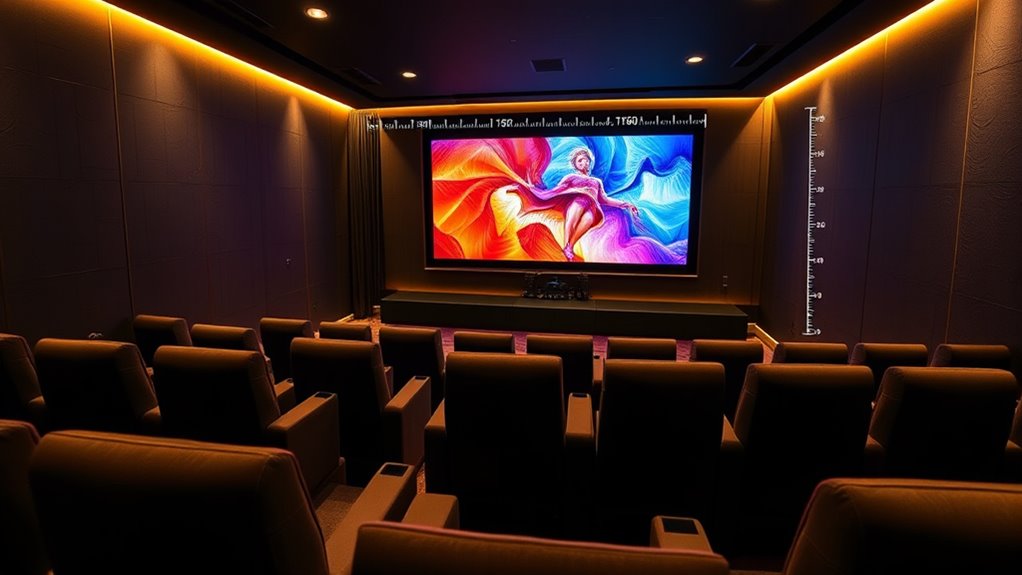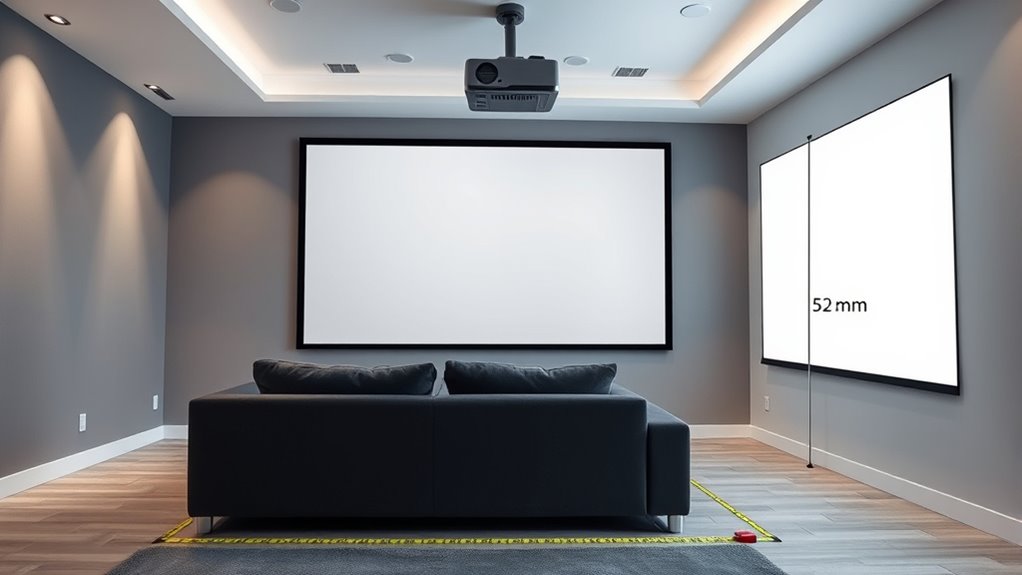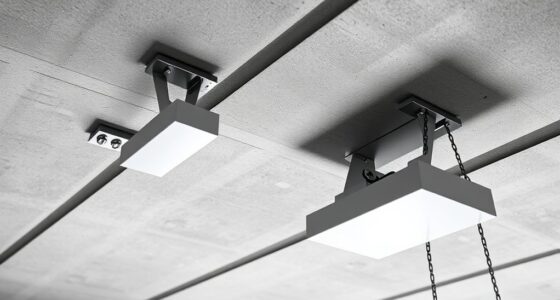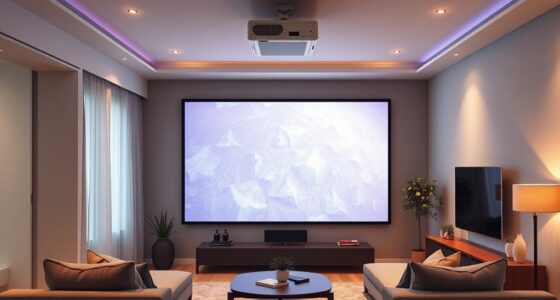To understand throw ratios and room depth, you need to know that throw ratio is the ratio of the projector’s distance to the screen size. Larger room depths mean you might need a projector with a higher throw ratio or longer distance to get a big enough image. Shorter rooms or limited space benefit from low throw ratio projectors, allowing closer placement. If you want to get your setup just right, exploring these details further can really help perfect your projection.
Key Takeaways
- Throw ratio determines the projector’s placement distance relative to screen width, affecting room setup.
- Measure room depth accurately to select a projector with an appropriate throw ratio for desired image size.
- Higher throw ratios need more distance, suitable for larger rooms; lower ratios allow closer placement in smaller spaces.
- Proper understanding of throw ratio simplifies calibration, ensuring the image fits the screen without distortion.
- Accessories like lens shift can help fine-tune projection when room dimensions or throw ratios are limited.

When choosing a projector for your space, understanding throw ratios and room depth is essential to guarantee a perfect fit. Throw ratio determines how large an image the projector can produce at a given distance, directly influencing your screen size selection. If you overlook this, you risk ending up with a setup that’s either too small for your room or so large that it can’t be properly projected. By grasping the relationship between throw ratio and room dimensions, you can plan your projection calibration more accurately, ensuring sharp, clear images without distortion or misalignment.
Understanding throw ratios and room depth ensures perfect projection fit and image clarity.
The throw ratio is expressed as a simple formula: the distance from the projector to the screen divided by the width of the projected image. For example, a projector with a 1.5:1 throw ratio means that for every foot of screen width, the projector needs to be 1.5 feet away. Understanding this ratio helps you determine where to position your projector within your room. If your room depth is limited, you’ll want a short-throw projector with a low throw ratio, allowing you to place it closer to the screen while still achieving your desired size. Conversely, larger rooms can accommodate projectors with higher throw ratios, which may be placed farther back and still produce a sizable image.
Room depth plays a significant role in your projection setup. Measure your space carefully before selecting a projector. If the distance from where you’ll mount or place the projector to the wall or screen exceeds the projector’s throw capabilities, your image will either be too small or require repositioning. Proper understanding of room depth helps you optimize projection calibration, ensuring the image fills the screen appropriately without cropping or stretching, which can degrade quality. Additionally, considering projection calibration and accessories like lens shift and keystone correction can help fine-tune your setup for irregular room shapes or placement constraints.
In addition, when planning for projection calibration, consider how the projector’s lens shift and keystone correction features can help fine-tune the image positioning and geometry. These adjustments are especially helpful in rooms where exact placement isn’t feasible or where room dimensions are irregular. By factoring in throw ratio and room depth, you can select a projector that not only fits your space but also simplifies the calibration process, leading to a more seamless viewing experience.
Frequently Asked Questions
How Do Ambient Light Conditions Affect Throw Ratio Choices?
Ambient light conditions critically influence your throw ratio choices because brighter rooms require a projector with higher brightness, or lumens, to guarantee clear images. In well-lit spaces, you should opt for a shorter throw ratio to get a larger image without sacrificing brightness. Conversely, in darker environments, a longer throw ratio works well, as ambient lighting has less impact, allowing for more flexibility in projector placement and maintaining image quality.
Can Room Shape Influence Optimal Throw Ratio and Placement?
Yes, room shape can influence your ideal throw ratio and placement. Curved ceilings may require adjustments to projector placement to guarantee proper image alignment, while asymmetric layouts can create uneven distances between the projector and screen. You might need a different throw ratio or reposition the projector to accommodate these irregularities, ensuring a clear, well-aligned display. Always consider these factors for the best viewing experience.
What Are Common Mistakes When Calculating Room Depth for Projectors?
Did you know that nearly 60% of projector setup errors stem from miscalculating room depth? When determining room depth, avoid common mistakes like ignoring ceiling mounting height or skipping projector calibration. You might also underestimate the space needed for proper lens shift or throw distance. Always measure carefully, account for ceiling mounting, and calibrate your projector correctly to guarantee ideal image size and quality without surprises.
How Do Lens Shift and Zoom Features Impact Throw Ratio Considerations?
Lens shift and zoom features directly impact throw ratio considerations by offering flexibility in projector placement and image size. Lens shift allows you to adjust the image vertically or horizontally without moving the projector, reducing the need to match exact throw ratios. Zoom features let you change the image size without repositioning the projector, allowing you to adapt to different throw ratios and room setups, making installation more versatile and less restrictive.
Are There Specific Projector Models Ideal for Small or Irregular Rooms?
This room is a tiny universe, so you need a projector tailored for small or irregular spaces. Look for models with flexible lens shift and zoom capabilities, making projection calibration easier and ensuring ideal image quality. Compact projectors like the Epson Home Cinema 880 or Optoma ML750ST excel in small rooms, allowing you to select the perfect screen size without sacrificing clarity. These models maximize space and deliver stunning visuals in tight spots.
Conclusion
So, next time you obsess over throw ratios and room depth, remember—despite all the numbers, it’s easy to forget that the perfect setup still depends on your personal taste. Ironically, the more precise you get, the more you realize how unpredictable everything remains. In the end, no matter how perfect the math, your viewing experience still hinges on a little bit of magic—something no ratio can fully guarantee.















